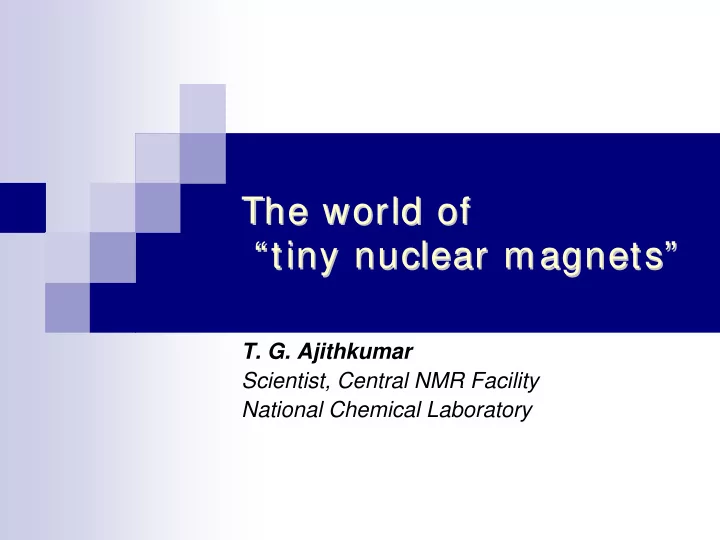

The world of The world of “ tiny nuclear magnets tiny nuclear magnets” ” “ T. G. Ajithkumar Scientist, Central NMR Facility National Chemical Laboratory
Why Nuclear Magnetic Resonance Spectroscopy (NMR) ? The most powerful analytical tool for synthetic chemists. Study of reaction kinetics. Three dimensional structural studies (protiens, RNA/DNA complexes). Structure function relationships for drug design. In medicine, magnetic resonance imaging (MRI) has become a very important diagnostic tool. Solids state NMR to study structure and dynamics of a variety of materials like polymers, catalysts, nanomaterials.
MRI
MRI of human brain Data sources : Left - The Whole-brain Atlas, K. A. Johnson and J. A. Becker, Harvard; Right - SMIS UK Ltd.
Magnetism
Magnetic Field
B B µ µ Low Energy High Energy
The atom
The origin of magnetism orbital magnetic moment magnetic field generated by orbital + motion proton - electron orbital motion
Magnetic moments nuclear magnetic moment electron magnetic moment + - The nuclear magnetic moment is many orders of magnitude weaker than the electron magnetic moment.
No external Field In the absence of a Magnetic Field, the magnetic moments are aligned in all random directions and thus the net magnetic moment is zero
On application of external Field B B N S N S A bar magnet aligns itself in the direction of the magnetic field !
Larmour Precession B B Precession/Larmour Frequency = - B Larmour Frequency (MHz/T) of important nuclei 1 H 42.576 13 C 10.705 31 P 17.235 Usually, an NMR spectrometer is named based on the 1 H Larmour Frequency Thus, a spectrometer which has a field of 7.05 T is called a 300MHz spectrometer 9.4 T is called the 400 MHz spectrometer, 11.74T called a 500MHz spectrometer
Net Magnetic B B Moment Thermal Equilibrium
Resonance An experiment to demonstrate Resonance using a spring and motor. The Larmour Frequency is in the Radio Frequency Range.
Electricity from magnetism The experiment where an oscillation magnet in a coil generates a alternating current.. Very similar to the NMR signal !!!
Application of Radio Frequency B Net Moment z y x B z z z y y y x x x
NMR Signal Coil y z x B t t NMR signal M y M x
Magnet Probe 7 5 Duplexer Signal Amplifier 6 Amplifier 3 Re Receiver Pulse Gate 8 Im ADCs 9 Phase Shifter Im Re 2 Post-Dig Phase Synthesizer Shifter 1 10 Im Re Pulse Programmer Computer Display, 4 11 Plot
Magnet bore liquid N 2 liquid He superconducting solenoid
Probe Rotation (Optional) B Sample Sample Coil Capacitor Capacitor C T C M
Chemical Shift 0 B electrons The field experienced by the nucleus in a molecule will depend on the electron environment..
NMR Imaging Along with the external field, a field gradient which is propotional to the geometry is applied
Nobel Glories of NMR 1954 1990 2002 2003 Physics Chemistry Biology Medicine Lauterbur Bloch Purcell Ernst Wuthrich Mansfield
In the winter of our first experiment….looking on snow with new eyes. There the snow lay around my door step….great heaps of protons quietly precessing in the Earth’s magnetic field. To see the world for a moment as something rich and strange is the private reward of many a discovery. Ed Purcell, 1946
Acknowledgements Dr. T. S. Mahesh, IISER for his help in setting up the demo experiments.
Recommend
More recommend